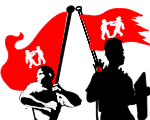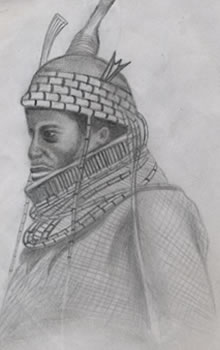|
||||||||||||||
|
||||||||||||||
role to his brother, Oba Esigie, and at first tried to make Udo the capital of Benin kingdom with himself as king. It didn´t take too long before the two brothers went to war. The war was difficult, bitter, and long drawn out. It was not until the third campaign that Udo was defeated. The third campaign was timed to coincide with the planting season when Udo citizen-soldiers, who were mainly farmers, would be busy on their farms. The Enogie´s only son, Oni-Oni, died in the battles. Even after that defeat, Udo Iyase and commander of their troops, returned to the offensive and after his defeat, the people of Udo escaped to found Ondo town deep in Yoruba territory.
The Enogie of Udo committed suicide by drowning at the Udo lake after his defeat. He did not want to be captured prisoner and taken back to Benin. Before jumping into the lake, he left his ´Ivie necklace,´ the precious bead necklace symbol of authority in Benin land, dangling from a tree branch were it could be easily found. Only the Oba could inherit such trophies of dead or conquered leaders and nobles, so, out of excitement over his victory, he tried on his neck for size, his brother´s humble surrender necklace symbol. He became mentally disoriented immediately he put the necklace on his neck. Removing the necklace from his neck did not make any difference, so he was rushed back to Benin City in that hopeless state. His mother, Idia, immediately located a Yoruba Babalawo (mystic) at Ugbo/Ilaje, in the riverine area, and brought him to Benin to work on the king´s spiritual ailment. He cured the Oba of his ailment, and the Queen after rewarding him generously, prevailed on him, (the Yoruba Awo), to settle permanently in Benin to continue to render his services. He set up home at Ogbelaka quarters where his descendants have thrived until this day. Idia, the Queen mother of Oba Esigie, commands a special place of honour in Benin history. She was a noted administrator and a great Amazon and influence on her son, Oba Esigie. She was personally involved in many of the wars of conquest by the Oba and even led some of them herself. Her image is eloquently captured in the famous Ivory mask, which served as the logo of the 2nd World Black and African Festival of Arts and Culture (FESTAC), held in 1977 in Lagos, Nigeria. The exquisite craftsmanship of the mask bears testimony to the quality of life and superlative level of civilization of the Benin people prior to their colonization. Three hundred and ninety-three years later, when the British invaded Benin kingdom and carted away their Ivory and bronze works before burning the city down, they described Edo works of art as symbols of barbarism and human sacrifice. Onitsha in eastern Nigeria, was founded by the Edo during Oba Esigie´s reign. The Portuguese, a major European power at the time, happily negotiated and established diplomatic and trade relations with him and his kingdom, Benin. The first such relationship between a West African country and a European country. His son was the first accredited African envoy to the Portuguese court. One of the numerous elite palace associations was assigned the responsibility of conducting affairs with the Portuguese. Until this day, a secret language, which some claim is derived from a mixture of Portuguese and Edo languages, is spoken by members of the association. Portuguese mercenaries fought along side the Bini in many territorial wars after the treaty. Trade between the Portuguese and Benin was mainly in coral beads, cloths for ceremonial attire, and great quantities of brass manilas, which Bini craftsmen melted for casting. In exchange for Portuguese goods, the Bini offered tobacco, spices, colanuts, ivory, earthenware, jewelry, artifacts, woven cotton materials, etc. Benin City is where Christianity was first preached in Nigeria. A Catholic church was opened in Benin in 1505. The Portuguese failed to persuade Oba Ewuare and Oba Ozolua but made their first break through with Oba Esigie, to the shock and disbelief of the Uzama nobles. With the Oba´s determination to have his way and replace Benin practices and faith with Christian ones, the Uzama nobles ostracized him. He retaliated by creating a parallel Uzama, headed by chief Inneh of Igun Street. His new Uzama was called Uzama N´Ibie and had, apart from their leader, Chiefs Ogieamien, Elema, Ogiehor and three others. The original Uzama mocked the new one to no end for breaking with tradition by living with the monarch in inner Benin. The new Uzama tried to gloss over the inconsistencies with ineffective symbolic projects and gestures until the conflict escalated into war between the two Uzama groups. Oba´s army took side with their Uzama, of course, and they eventually defeated the original Uzama nobles. The battle is commemorated at the palace yearly as the Igie Iron. The original Uzama, led by Oliha, decided that a change of Oba was necessary, and recruited the Atta of Igalla for the job. According to Samuel Ajayi Crowther´s River Niger Exploratory report 1854, “The first Atta of Idah was an Ado (Edo) man, a tribe which the Aboh people call Idu. He was a hunter who settled on Idah in Igarra. A quarrel arose and he drove Igarra king of Idah away and became the king of the place. Oyingbo, who was the Atta during Esigie's time, assured of fifth columnists support inside Benin, welcomed the opportunity to invade and subdue the almighty Benin. He left his capital, Idah, with a large army and after crossing the River Niger, began merciless pillaging of communities on his way to Benin and meeting with no resistance of any sort on the way. At Ahor town with a large population and ten Dukedoms, on the opposite side of Ikpoba River, which he had to cross to enter Benin City, Atta sacked and destroyed nine of the principalities. The one that miraculously escaped his archers and swordsmen is the Abor community, and the only one in existence today. After Ahor, he swept furiously through Oregbeni village to begin his descend of Ikpoba hill still meeting with no resistance so far in his campaign, trailed with a great deal of wreckage and deaths. As he prepared to ascend Ikpoba slope to enter Benin City, guns concealed in the lush forest around the valley, manned by Portuguese missionaries and traders, opened fire on Atta´s army from all sides. Such fire power was strange at the time to the Igallas and the Edo people. In the twinkling of an eye, hundreds of the invading army had fallen, so what was left of them fled back up the valley, pursued by Benin army, all the way to Idah across the River Niger. The defeated Atta then became a vassal of Benin. Encouraged by the victory, Oba Esigie turned his full attention and energy on promoting Christianity. He built a Cathedral on the Aruosa site at Akpakpava Road and a chapel each, perhaps intended to serve as schools, at Erie, Ugbague and Ogbelaka quarters. Christian rituals, including morning mass, were introduced into palace usage, and Christian motifs, such as the cross of four equal arms, which was the form of cross the Portuguese first introduced to Benin, were reproduced on the Ada, Eben, and the regalia of the Oba and his chiefs. Oba Esigie´s first son and Oba-in-waiting, Edaiken Prince Orhogbua, was given to the Portuguese to train as a Catholic priest. He became the most highly educated in western education, of the Benin princes until Oba Akenzua II in 1933 CE. The Portuguese appeared to have first trained Orhogbua at the Bishopric of Sao Tome before transferring him to Lisbon to continue his education. When his father died in 1550 CE, he was still overseas. He was seen by Edo people as a Portuguese, and of course, he spoke perfect Portuguese. European slave trade in West Africa started with the acquisition of domestic servants in 1522, and warrior kingdoms like Benin had plenty of them captured as war booties, but would not sell them. The slave trade was very unpopular with the Edo people. They thought it was silly to sell fellow human beings. Their Obas and nobles were vehemently opposed to the business of slave trade and to the export of the productive fighting male. The Edo, of course, could not control the day to day happenings of the slave merchants, who apparently largely acted under cover at first in the vast territories under Edo hegemony. However, it was forbidden to sell or take a native Bini into slavery and so elaborate identification marks on faces and chests were eventually contrived. The Bini, therefore, were hardly ever captured by Arabs or Europeans into slavery. Alan Ryder, writing on this in his book: Benin and the European, narrated the experience of the Portuguese merchant, Machin Fernandes in Benin as early as 1522: That was during the reign of Oba Esigie. “Of the whole cargo of 83 slaves bought by Machin Fernandes, only two were males and it is quite possible that these were acquired outside the Oba's territory despite a whole month (at Ughoton) spent in vain attempts to have a market opened for male slaves. The 81 females, mostly between ten and twenty years of age, were purchased in Benin City between 25 June and 8 August at the rate of one, two or three a day.” None of the 83 slaves was an Edo person, according to Ryder, and no Edo person could have been involved in the sales. It was taboo in Edo culture. Edo Empire was vast, with a great concentration of people from different ethnic backgrounds, Yoruba, Ibo, Itsekiri, Ijaw, Urhobo, Igalla etc., making a living in the lucrative Ughoton route that was the main centre of commercial activities in the southern area at the time, of what later became Nigeria. Alan Ryder, recording the experiences of yet another European merchant, the French trader and Captain called Landolphe, in Benin in February 1778, said, “the Ezomo was the richest man in Benin, owning more than 10,000 slaves, none of whom was ever sold.” The author then commented: “His (the Ezomo) refusal to sell any of his slaves is also noteworthy for the light it sheds upon the attitude of powerful Edo chiefs towards the slave trade: however numerous they might be, a great man did not sell his slaves.” Says Edo people: “vbo ghi da Oba no na mu ovionren khien?” Meaning, “what need does the Oba want to satisfy by putting out his slave for sale?” Oba Esigie contrived his own death as an atonement or sacrifice for his spiritual shortcomings. He allowed himself to be mistakenly killed by his own security guards while feigning to be an intruder into the palace grounds, with his head covered with calico hood, and thrusting it through a hole he made in the security fence. The intruder had played the trick two times earlier and was third time unlucky. It all happened within a couple of days and security guards where at full alert and prepared for the intruder that third time, almost severing the head off, only to discover they had killed their king.
Comment Form is loading comments...
|
||||||||||||||
|
| ||||||||||||||






